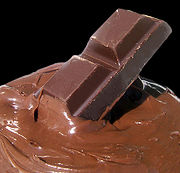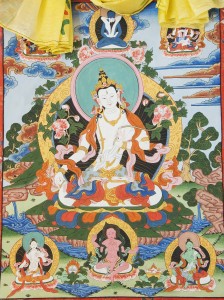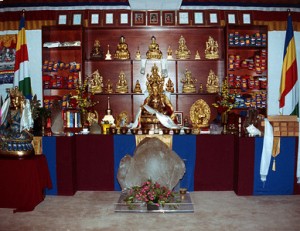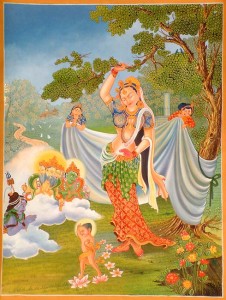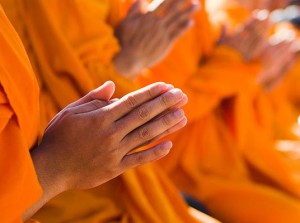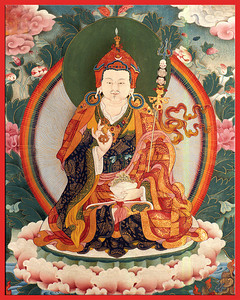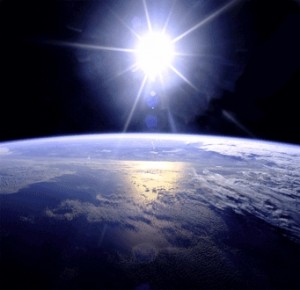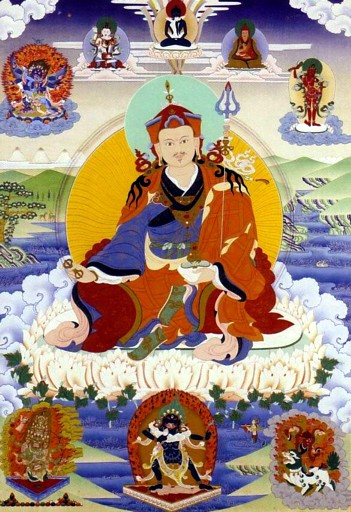Uncategorized
The Search for I
An excerpt from a teaching by Jetsunma Ahkon Lhamo from the Vow of Love Series
All conceptualization, all phenomena arise from the belief in self-nature and from the compulsion, at that point, to make self appear separate from other, making a reactive relationship necessary. Your entire mind consists of the phenomena of hope and fear, of discrimination in a subtle and dense way. But the nature of mind itself remains steadfast, clear, uncontrived. When there is no concept of self. It is pure, perfect. It is only suchness. Only that. It cannot be altered. It remains unchanged. And the weird thing about it is, the minute that you start talking about it, you’ve removed yourself from the potential to understand it.
When you look at a crystal, it might be understood as a symbol of suchness. Now, if you were wearing a blue shirt and you put your arm behind the crystal, you would then see blue. Has the crystal become blue? Well, you have to look at it on two levels. With your arm behind it, the crystal looks blue. So, in that sense, the crystal appears to have become blue. But if you move your arm away does the crystal change? Is it still blue? So what is blue? Who perceives blue? The crystal is the same. It is the same. It is completely unaltered. What is this appearance of blue? What is this appearance of phenomena in general? This appearance of phenomena, in general, is merely conceptualization. Who perceives it?
Here is a very crude example, but then I told you I was born in Brooklyn. I’m not making any apologies. That’s it. Let’s take two objects: we have chocolate, and we have shit. Yes, shit, you heard it right! We have chocolate and we have shit. Okay, they’re both brown. I’m sorry, but we have to do this. They’re both brown, right? They both have a creamy consistency. So sorry! They both have a strong aroma. What makes one chocolate and the other one shit? Who determines the difference? Who is the taster? Who sees this? Who sees that? What is happening here?
How do you get free then of distinction between shit and chocolate? How do you stop seeing the blue in the crystal? How do you perceive that true nature? Little by little, you have to disengage the idea of self, and you have to meditate on that. I recommend that you begin in this way, whether you are a dyed-in-the-wool Buddhist, or whether you are a person that has never even heard of any of this before. I don’t recommend that you taste both shit and chocolate, but you can try, let’s say, honey and lemon juice. Look for yourself and ask, “Who is the taster?” You say, “I taste.” Then, “Where am ‘I’?” Well, “I’m right here.” Okay, where are you here? Let’s take you apart. Let’s find out where ‘I’ is. We’ll look first in the feet. We’ll start low and work up. Did you find ‘I’ in your feet? Take them apart. Really, you have to make slides of everything. You have to buy yourself a microscope and make slides and see if you can find ‘I,’ okay? Go all the way up. Look everywhere that you can, examine every single molecule. Go all the way up to the heart. Everybody thinks hearts are big these days. Let’s look in the heart and see if we can find ‘I.’ Then, we’ll look in the throat. What part do you identify with the most? Do you have great legs? We’ll look at your legs. Do you have a beautiful figure? We’ll look at every part of it. Look at everything! Let’s look in the brain. Everybody thinks they come from their head, right? So we’ll look in the brain. Where is ‘I’? You can even look in your eye, in your eyeball. See if you can find ‘I’ there.
No matter how hard you look, even if you make microscopic slides of every single part, you will not find ‘I’ in this body. You will not find it! Well, you say there must exist an ‘I,’ because how else can I go from lifetime to lifetime? And, I’m telling you that the idea of ‘I’ is only that. It is a conceptualization that has built around it so much karmic flatulence that the profundity of it has managed to exist for lo these many eons. At that point, you can begin to understand that, essentially, nothing has happened. In truth, nothing has happened. And you can begin to meditate on the emptiness of all phenomena.
Copyright © Jetsunma Ahkon Lhamo. All rights reserved
21 Homages to Tara


The Twenty‐One Homages to Tara
OM JETSÜMA PHAGMA DROLMA LA CHAG TSAL LO
OM To Jetsunma Arya Tara, I bow down.
CHAG TSAL DROLMA NYUR MA PAL MO
CHEN NI KE CHIG LOG DANG DRA MA
JIG TEN SUM GÖN CHU KYE SHAL GYI
GE SER JE WA LEI NI JUNG MA
Homage, Tara, quick and brave, with eyes that flash like lightning, born from the open corolla of
the lotus face of the protector of the three worlds.
CHAG TSAL TÖN KI DA WA KÜN TU
GANG WA GYA NEI TSEG PAI SHAL MA
KAR MA TONG TRAG TSOG PA NAM KYI
RAB TU CHE WAI ÖD RAB BAR MA
Homage, the lady whose face is filled with a hundred autumn full moons, blazing with the free
light of thousands of stars
CHAG TSAL SER NGO CHU NEI KYE KYI
PEDME CHAG NI NAM PAR GYEN MA
JIN PA TSÖN DRÜ KA THUB SHI WA
SÖD PA SAM TEN CHÖD YUL NYID MA
Homage, Lady whose hand is adorned with a golden‐blue, water‐born lotus whose realms of
practice is generosity, effort, austerity, peace, patience and meditation.
CHAG TSAL DE SHIN SHEG PAI TSUG TOR
THA WEI NAM PAR GYAL WAR CHÖD MA
MA LÜ PHA ROL CHIN PA THOB PAI
GYAL WAI SEI KYI SHIN TU TEN MA
Homage, Lady with Tathagata crown, enjoying infinite victory, attained all perfections, served by
the sons of the Buddha.
CHAG TSAL TUTARA HUNG YI GE
DÖD DANG CHOG DANG NAM KHA GANG MA
JIG TEN DÜN PO SHAB KYI NEN TE
LÜ PA MED PAR GUG PAR NÜ MA
Homage, Lady filling the desire realm, the directions and space with TUTTARE and HUM,
trampling the seven worlds with her feet, able to summon all
CHAG TSAL GYA JIN ME LHA TSANG PA
LUNG LHA NA TSOG WANG CHUG CHÖD MA
JUNG PO RO LANG DRI ZA NAM DANG
NÖD JIN TSOG KYI DÜN NEI TÖD MA
Homage,Lady worshiped by Indra, Agni, Brahma, Pavana and Vishveshvara, praised by hosts of
spirits, ghosts, gandharvas and yakshas.
CHAG TSAL TRAG CHE JA DANG PHET KYI
PHO ROL TRUL KHOR RAB TU JOM MA
WEI KUM YÖN KYANG SHAB KYI NEN TE
ME BAR TRUG PA SHIN TU BAR MA
Homage, Lady who destroys others’ magic devices with TRAD and PHAT, trampling with left
foot up and right extended, blazing with a mass of blazing fire.
CHAT TSAL TU RE JIG PA CHEN PÖ
DÜD KYI PA WO NAM PAR JOM MA
CHU KYEI SHAL NI TRO NYER DEN DZED
DRA WO THAM CHED MA LÜ SÖD MA
Homage, Lady who destroys the heroes of Mara with fearful TURE, with the angry lotus face,
slayer of all enemies
CHAG TSAL KÖN CHOG SUM TSÖN CHAG GYAI
SOR MÖ THUG KAR NAM PAR GYEN MA
MA LÜ CHOG KYI KHOR LÖ GYEN PAI
RANG GI ÖD KYI TSOG NAM TRUG MA
Homage, Lady adorned with fingers over the heat in the mudra inducating the three Jewels,
adorned with the universal wheel, swirling with masses of its light.
CHAT TSAL RAB TU GA WA JID PAI
U GYEN ÖD KYI TRENG WA PEL MA
SHED PA RAB SHED TUTTARA YI
DÜD DANG JIG TEN WANG TU DZED MA
Homage, Lady diffusing garlands of light from her joyous, shining crown, subjugating the world
with laughing, mocking TUTTARE.
CHAG TSAL SA SHI KYONG WAI TSOG NAM
THAM CHED GUG PAR NÜ PA NYID MA
TRO NYER WO WAI YI GE HUNG GI
PHONG PA THAM CHED NAM PAR DROL MA
Homage, Lady able to summon all the hosts of the earthʹs protectors, saving from all poverty by
the movement of her angry brows and the letter HUM.
CHAG TRAL DA WAI DUM BUI U GYEN
GYEN PA THAM CHED SHIN TU BAR MA
RAL PAI TRÖD NEI ÖD PAG MED LEI
TAG PAR SHIN TU ÖD RAB DZED MA
Homage, Lady blazing with all jewels, head ornament a crescent moon, continually blazing with
light from Amitabha on her mass of piled hair.
CHAG TSAL KAL PA THA MAI ME TAR
BAR WAI TRENG WAI Ü NA NEI MA
YE KYANG YÖN KUM KÜN NEI KOR GAI
DRA YI PUNG NI NAM PAR JONG MA
Homage, Lady located in the center of a blazing garland like the fire at the end of the aeon, in a
joyous posture, right leg extended, left up, conquering the army of the enemy.
CHAG TSAL SA SHI Ö LA CHAG GI
THIL GYI LÜN CHING SHAB KYI DUNG MA
TRO NYER CHEN DZED YI GE HUNG GI
RIM PA DÜN PO NAM NI GEM MA
Homage, Lady touching the earth with her palm, pounding it with her feet, frowning angrily, the
letter HUM subduing the seven stages
CHAG TSAL DE MA GE MA SHI MA
NYANG NGEN DEI SHI CHÖ YUL NYID MA
SO HA OM DANG YANG DAG DEN MEI
DIG PA CHEN PO JOM PA NYID MA
Homage, Lady blissful, virtuous, peaceful, whose realms of practice is peaceful Nirvana, with
SOHA and OM conquering great negative actions.
CHAG TSAL KÜN NEI KOR RAB GA WAI
DRA YI LÜ NI RAB TU GEM MA
YI GE CHU PAI NGA NI KÖD PAI
RIG PA HUNG LEI DROL MA NYID MA
Homage, Lady by total joy destroying the bodies of enemies, saviouress arisen from HUM in the
mantra composed of ten letters.
CHAG TSAL TU REI SHAB NEI DAB PEI
HUNG GI NAM PAI SA BÖN NYID MA
RI RAB MEN TA RA DANG BIG JED
JIG TEN SUM NAM YO WA NYID MA
Homage, Lady, the seed of the form of HUM, striking with feet of TURE, shaking Mountain
Meru, Mandara, Kailasha and the three worlds.
CHAG TSAL LHA YI TSO YI NAM PAI
RI DAG TAG CHEN CHAG NA NAM MA
TA RA NYI JÖD PHET KYI YI GEI
DUG NAM MA LÜ PAR NI SEL MA
Homage, Lady holding the ʺdeer‐markedʺ, in the form of a sea of gods, with twice spoken TARA
and the letter PHAT cleansing all poisons.
CHAG TSAL LHA YI TSOG NAM GYAL PO
LHA DANG MI‐AM CHI YI TEN MA
KÜN NEI GO CHA GA WAI JID KYI
TSÖD DANG MI LAM NGEN PA SEL MA
Homage, Lady served by the king of the hosts of gods, by gods and spirits with the brilliance of
her joyous total armour dispelling disputes and bad dreams.
CHAG TSAL NYI MA DA WA GYEI PAI
CHEN NYI PO LA ÖD RAB SAL MA
HA RA NYI JÖD TUTTARA YI
SHIN TU DRAG POI RIM NED SEL MA
Homage, Lady shining with the light of two eyes, the sun and full moon, with twice spoken
HARA, and TUTTARE, curing terrible fevers and illnesses.
CHAG TSAL DE NYID SUM NAM KÖD PEI
SHI WAI THU DANG YANG DAG DEN MA
DÖN DANG RO LANG NÖD JIN TSOG NAM
JOM PA TU RE RAB CHOG NYID MA
Homage, Lady truly possessing the strength of peace by the array of the three essences,
conquering the hosts of demons, ghosts and yakshas, supreme Lady TURE.
TSA WAI NGAG KYI TÖD PA DI DANG
CHAG TSAL WA NI NYI SHU TSA CHIG
This is the praise of the root mantra, and the Twenty‐one Homages.
Benefit Verses
LHA MO LA GÜ YANG DAG DEN PAI
LO DEN GANG GI RAB DANG JÖD TE
Recited by an intelligent man, with true devotion to the goddess,
SÖD DANG THO RANG LANG PAR JE NEI
DREN PEI MI JIG THAM CHED RAB TER
Arising at evening or dawn and remembering them, they grant all fearlessnesses,
DIG PA THAM CHED RAB TU SHI WA
NGEN DRO THAM CHED JOM PA NYID DO
Pacify all negative actions and conquer all evil existences.
GYAL WA JE WA TRAG DÜN NAM KYI
NYUR DU W ANG NI KUR WAR GYUR LA
Quickly being initiated by seventy million Buddhas, thereby achieving greatness,
DI LEI CHE WA NYID NI THOB CHING
SANG GYE GO PHANG THAR THUG DER DRO
He will pass to the ultimate of Buddhahood.
DE YI DUG NI DRAG PO CHEN PO
TEN NEI PA‐AM SHEN YANG DRO WA
Even if he has eaten or drunk terrible poison, either inanimate or animate,
ZÖ PA DANG NI THUNG PA NYID KYANG
DREN PEI RAB TU SEL WA NYID THOB
By remembering them one will obtain purification.
DÖN DANG RIM DANG DUG GI ZIR WAI
DUG NGAL TSOG NI NAM PAR PANG TE
All the sufferings of demons, fevers and poisons are gone.
SEM CHEN SHEN PA NAM LA YANG NGO
NYI SUM DÜN DU NGÖN PAR JÖD NA
Even for other beings, if they are clearly recited two,
three and seven times,
BU DÖD PEI NI BU THOB GYUR SHING
NOR DÖD PEI NI NOR NAM NYID THOB
If one wishes a son, one will obtain a son. If one wishes wealth, one will obtain wealth.
DÖD PA THAM CHED THOB PAR GYUR LA
GEG NAM MED CHING SO SOR JOM GYUR CHIG
All wishes will be obtained, without hindrance, all will be conquered.
OM TARE TUTTARE TURE SO HA
GYAL YUM DROLMA KYED KU CHI DRA DANG
KHOR DANG KU TSE TSED DANG SHING KHAM DANG
Oh, Dolma, Mother of all the Buddhas, all forms are yours, all containers contained, and all realms are
yours. May their duration and ling life endure,
KYED KYI TSEN CHOG ZANG PO CHI DRA WA
DE DRA KHO NAR DAG SOG GYUR WAR SHOG
And in the excellence of all your goodness and sacred marks,
may we become identical with you in every way.
KYED LA TÖD CHING SOL WA TAB PEI THÜ
DAG SOG GANG NA NEI PAI SA CHOG SU
By the power of this prayer and hymn of praise,
may I and all others, wherever they may be, in every direction,
NED DÖN WUL PHONG THAB TSÖ SHI WA DANG
CHÖ DANG DRA SHI PHEL WAR DZE DU SOL
Have all our poverty, illnesses, obsessions and wars pacified.
Any may the hold Dharma and good fortune increase without end.
For a PDF download: https://www.tibetanbuddhistaltar.org/2010/06/21-homages-to-tara-pdf-download/
Mindfulness Brings Awakening
An excerpt from the Mindfulness workshop given by Jetsunma Ahkon Lhamo in 1999
For all students, when they see the sacred, whether it’s a text or a holy image, it is an opportunity to practice and it’s an opportunity for recognition. It’s an opportunity to practice the View – to get that coarseness and dullness out of our minds.
As practitioners, we should never, even for a moment, point our feet at a sacred image. You might think, “Ah, that’s for another culture,” but no, it’s not. There is a thing that happens in your mind when you’re kicking back and you’ve got your feet up and you’re pointing it at something holy. The mind goes to sleep. Inwardly, subtly, you simply go to sleep. Believe me when I tell you, you leave yourself wide open for real negativity to come out at that very time, because there was an opportunity for recognition, and there was a choice of non-recognition. That puts more weight in the shit pile, not the Dharma pile. See, we have two piles – shit and Dharma. Those are the choices. Just trying to be real clear about this.
When we practice this non-recognition, we are going deeper and deeper into suffering. The mind becomes more inflamed, thicker, looser as in sloppy. In actuality, in some ways it’s much tighter. The mind is very reactive. When we practice viewing the sacred and taking that little moment to practice the humility of lifting up that sacred image in our minds and really recognizing that, at that moment the mind is not concentrating on ego-clinging; it is not concentrating on desire; it is not concentrating on how you feel or what you want or what you don’t have; it is not concentrating on what you have to do next to make yourself happy. It is practicing something different, and every opportunity to recognize the sacred in one’s life is a good one, particularly when you’re walking around not visibly practicing. So, we never point our feet at a sacred object or at the Lama.
I remember for a long time I had a problem with my leg. It was very swollen, and I had a hard time. I had to keep it elevated, for a couple of years actually. Now it’s a lot better, but it used to be that I had to, even in puja, taking empowerment from my teachers, put my foot up, and it was the worst time in my life. There were times I wished that I could cut my damn leg off. I felt that strongly about it. I’d just look down at that leg and think, “What the hell use are you, sitting there like that?” So I really felt very bad about that. What I would do is cover my leg with a blanket so no one could see it, and I was prayed that somehow that made it go away. That was something I had to deal with, and I didn’t like that at all. It felt wrong to me. However, for the most part we are healthy, and we are able to practice in such a way that we do not point our feet at any sacred object. This teaches us not to be slovenly in our minds, not to be forgetful, not to be mindless, but rather to be more mindful, and that is an antidote to suffering of all kinds.
Furthermore, Dharma texts should never be treated like regular texts. They should always be lifted up. They should never be on the floor. They should never be under you. Dharma is always held up because it is the path that the Buddha has given us. Not doing so brings a lot of obstacles because of the state of non-recognition, which is the root of the suffering. It’s the root of the problem. You don’t think that you’re disrespecting the Dharma. Let’s say I have a Dharma book over here and I’m in a really tight seat and somehow I just kind of lean over like that with my elbows on top of the Dharma book – not good. The Dharma book doesn’t care. And it’s not about what a good girl you are, or what a good boy you are. Nobody cares about that either. It is that non-recognition, that dullness, that sleeping state that is the problem. Every opportunity that we have that is taken to establish recognition is fruitful and very beneficial to us. Try to remember that you’re not doing anyone a favor if you practice this way. This is for you. This is about you. The book doesn’t need it, the teacher doesn’t need it, the bodhisattvas and the Buddhas, don’t need it; but you need it. It is your opportunity to practice recognition.
We are very careful about how we treat the books. When you finish reading a regular book, you just close it without thinking. That thickness of mind, that non-recognition should never happen with a Dharma book. When you close a Dharma book, do it mindfully. Even if you don’t do it physically, such as touching it to the top of your head, at least in some way internally, you should be doing something like that. Put it above the top of the head in some symbolic way in your own mind so that you’re gentle with it and mindful. Think, “These precious pages, what would we do if we didn’t have the Prayer to the Three Bodies of the Lama? What would we do if we didn’t have the Orgyen prayer? What would we do if we didn’t have the Seven-line Prayer?” We wouldn’t do anything because we wouldn’t have any practices. So this is so precious to us, and this mindfulness really is important. It really makes a difference.
Likewise, when you have an altar, whether it’s at the temple or at home, it should always be clean and free of dust. The bowls should always be clean, with no nasty ring around them because you didn’t wipe them. The offerings should be made every day. Of course, in opening one’s altar, automatically one is making offerings. That has to be done mindfully, and if you don’t have a regulation type altar yet, if you just have an image of the Buddha and offer one flower, a few grains of rice, a cup of water, something like that every day, that mindfulness brings an awakening to the sacred. Once again, it’s not for the picture; it’s for us. Conversely, not doing that, not having a sacred image, not having a way to establish the sacredness of any given day, hour, moment, life, produces obstacles. It can produce tremendous obstacles because, once again, we are floundering around, and maybe even willingly so, in a state of non-recognition. These things are very important.
© Jetsunma Ahkön Lhamo
The Value of Human Existence
The following is respectfully quoted from “Treasury of Precious Qualities” by Jigme Lingpa, with commentary by Longchen Yeshe Dorje and Kangyur Rinpoche, as translated by Padmakara Translation Group:
The Value of Human Existence:
1. So long enchanted in samsara’s wilderness,
Tormented by the cutting of their heads and limbs,
With seeds of future sorrow hidden in their minds,
Beings long so foolishly for bliss of higher realms.
2. From there they fall again, their states of mind destroying them,
To wander in three evil realms, or as insensate gods,
Or else in barbarous lands, with false views, handicapped,
In places where the Buddhas have not come.
3. On blazing iron grounds without reprieve,
With dreadful weapons wounded time and time again,
The denizens of hell are slain but cannot die–
Still tangled in the webs of hatred’s evil deeds.
4. What need is there to say that hungry ghosts are racked by want?
For food they find not even pus or blood or filth,
And streams and orchards dry before their eyes.
Their vitals burn in endless pain,
Their length of life uncertain,
Measured by the strength of obscuration.
5. Beasts prey on one another, are each other’s food.
And, hunter’s quarry, they are slain by cruel means;
Or caught and tamed, they are reduced to bondage.
Born to such great misery, what can they do?
6. The insensate gods, whose life-supporting karma is immense,
Live long in formlessness; no sorrow do they know.
But lacking support for learning and reflection,
At death they have false views and so lack freedom to progress.
7. Supported on the palaquin of legs and feet,
But yet with minds untouched by virtue,
Barbarous men live sunk and skilled in evil ways,
And wander in the jungles of false morality.
8. Some have senses that belie their promise.
Though they meet with teachers, holy and sublime,
They hear their words like echoes sounding from a cliff,
And suffer in the wasteland of no understanding.
9. Some achieve the great ship [of human life]
With wits like sails wherewith to cross the ocean of rebirth.
But overwhelmed by demons, the espouse false views,
Wherein the Buddha who has come takes no delight.
10. Some fall in blind and lightless chasms:
Ages where no Buddhas manifest.
And though they try to rise, they find no path
And in despair sink down from low to lower destinies.
11. Eight states therefore where beings are not free to practice Dharma,
Where world-destroying gales of sin and suffering rage,
Where merit is defiled in wariness and fear–
O think of this and profit from your freedom!
12. To be a human being in a pure and central land,
With limbs and senses whole, with faith in Buddha’s teaching,
With karmic fortune blossoming, unmarred by evil deeds–
And this is like the wishing-tree, extremely rare.
13. But rarer still, the Buddha, like an udumbara, has appeared within our world.
The flower of Dharma is in bloom. The garden of the doctrine,
Undiminished, still exists, and perfectly do holy beings enter it,
Within whose cooling shade we may find rest.
14. Such fortune in ourselves is rarer than the wishing tree;
Such outer circumstances are like udumbara flowers,
These ten together joined with eight-fold leisure–
Such coincidence will scarce be found again!
15. Examples make it clear–the turtle’s head, the floating yoke,
And numbers also, whereby humans in comparison with beasts
Are like stars that shine by day compared with those by night,
With, in a like proportion, hungry ghosts and denizens of hell.
16. If once aboard this great ship of our freedom,
We now fail to reach the far shore of this sea of pain,
This meeting with the helmsman will indeed have been in vain
For us who strive and fare upon the Dharma’s path.
Paying Homage
An excerpt from a teaching called The Seven Limb Puja: Viewing the Guru by Jetsunma Ahkon Norbu Lhamo on October 18, 1995
Since we find that we are, in fact, in the presence of the primordial Guru at every single moment, what is the posture that we should take? You should refer to the practice called the Seven Limb Puja. The Seven Limb Puja appears in many different practices in slightly different variations, but it has certain common denominators, and these should be studied and looked at as a guide of how one should practice now that one is coming to understand that the eyes of the Guru are our eyes; that the heart of the Guru is our heart; that in our nature, that is the nature. That is the nature, and we are indistinguishable in our nature from that.
Practicing in that way we should think like this. First of all, in the face of the Guru, knowing that the face of the Guru is always with us, we should practice paying homage constantly. Constantly paying homage to the Guru, this will antidote our pride, our ego, that habit that says, “Oh, well, look at that! The Guru has faults. He or she must be human.” And, of course, that is the statement that keeps you from practicing pure devotion and pure surrender, and the same statement that prevents you from achieving realization. So this is the antidote that helps you to give rise to that spiritual posture that makes it possible for you recognize the nature of the Guruas the absolute non-dual display of emptiness and luminosity; and to give rise to profound devotion at last, rather than the superficial stuff that we’ve been passing out as devotion.
We practice paying homage. We pay homage to the Buddhas and the Bodhisattvas; the Lamas are in that number. The Buddhas and Bodhisattvas are all represented in the Lama. We should think that we pay homage to the Buddhas because they have crossed the ocean of suffering. Therefore, they are capable of captaining us across the ocean of suffering. So we pay homage with that kind of regard, as though we needed to cross an ocean of suffering and the trip is scary and long and hazardous and difficult and so a qualified captain is required. Otherwise, we can’t make it. So that is the kind of recognition of the superior quality of the Buddhas and Bodhisattvas, of the Lama. Recognize every moment, this is a vajra command, that when we think of ourselves in our samsaric state and then we think of the Guru, we should think that the Guru is like a precious diamond, beyond compare, because the Guru is capable of helping us cross the ocean of suffering. We cannot do that ourselves. That will antidote the kind of pride that we have when we try to put ourselves above everything, in subtle or gross ways, whatever it happens to be.
© Jetsunma Ahkön Lhamo
Two Eyes of Practice
An excerpt from the Mindfulness workshop given by Jetsunma Ahkon Lhamo in 1999
Guru Rinpoche himself said, “I will appear as your Root Guru,” and that appearance is to be recognized. It demands to be recognized. One of the reasons why I harp so much on reciting the Seven line Prayer is because the Seven line Prayer is a prayer, the blessing of which creates the capability of seeing the Guru in all things, and of following the Guru and of practicing in such a way as to discriminate that absolute nature. The nature of that prayer is to begin to awaken our inner psychic channels and to bless our psychic channels and winds and fluids in such a way that everything within us that is the Buddhanature begins to awaken. That’s the power of that prayer, and it is done through the practice of recognizing and discriminating what is extraordinary. In order to provide for that kind of recognition, we have to put a lot more effort into that aspect of our practice than we have up until now.
Maybe I am giving you the impression that it’s all about Guru Rinpoche. For me it is, but maybe that’s because I’m lucky enough to have had enough teachings to have an understanding of Guru Rinpoche’s nature. When we talk about the nature of the Guru, we are talking about the perfect mating of wisdom and compassion, of emptiness and appearance. When you see the image of Guru Rinpoche, you always see that staff crooked in his arm, and that is the symbol of his consort. It indicates that the Lama is never separate from his consort, and the meaning of that is the non-duality and union of emptiness and appearance, of wisdom and compassion, or bodhicitta. That is the meaning of that union of Lama and consort. So Guru Rinpoche is always seen that way. We are to understand from that, then, that His nature is the perfect union of wisdom and bodhicitta, of the view of emptiness and the understanding of the display of appearances. That is Guru Rinpoche’s nature.
That being the case, we have to find a way to not only recognize the physical form of the Guru, the picture that looks like Guru Rinpoche or the picture that looks like your teacher. We really have to get past that and go into a deeper sense of trying to awaken and potentiate our own meditation, our own understanding, of the nature of emptiness and of the nature of appearances. We have to begin to potentiate and practice and meditate in such a way that we see wisdom and compassion as being like the two eyes of our practice.
Click here for a teaching on the Seven Line Prayer and audio files of Jetsunma chanting the Seven Line Prayer.
© Jetsunma Ahkön Lhamo
Silent Chant
An excerpt from a teaching by Jetsunma Ahkon Norbu Lhamo on October 18, 1995
We are talking about the Lama as being our own precious nature. Someday when we die and all the elements fall away, what will arise naturally is the natural state, free of contrivance. And they say for the practitioner there is realization, simply because, the practitioner that has meditated properly will recognize that natural uncontrived state as the very primordial mother from which they have sprung. And like a child who has been separated from his mother for a while runs to the mother with happiness and joy, and practically rips open his heart, and sits on the mother’s lap and doesn’t wish to separate from the mother at all — like that, if we are meditators, we will run to that nature. We will recognize with fervent regard, but so much more than that. I don’t even have the words.
Here in our lives, due to the force of our fortunate meritorious karma that we have accumulated in the past, when here in this life, that same uncontrived nature, that same pristine quality appears in samsara to speak to us, to see us with its eyes, to hold our hand, to teach us how to practice, and how to recognize in our practice, we’re drunk, light in the head, stupid. We can’t care, we can’t get it together. Our minds are just weak that way. And yet, even with all of that, even with all of our terrible practice, we are still hoping that when we die and those elements that make up our samsaric existence begin to disintegrate and fall away that somehow, magically, we will recognize the primordial wisdom nature. Boy, are you thinking like Peter Pan! That’s what I call magical thinking. The only way it is going to happen is if we can begin to recognize that nature now. And the only proper way to recognize the nature of the Guru is to simultaneously recognize our own nature as well, and to know that they are indistinguishable.
It is not possible for us to look at the Guru and find fault, because that would mean that we are acting with samsaric intention, with samsaric mind, and the result is samsara. There is no practice there. That is nothing. You do that all the time. You do that every moment. That’s not practice. But if we think and practice in the way that I’ve just discussed with you, then instead, when we see the Guru we see literally the face of salvation. We see literally: “I am that. That I am.” Even though, of course you can’t say “I.” “I” separates us, but in the beginning, we have the intention of understanding: that is the nature that is my nature also.
And so inside — instead of judgment, hatred, greed, ignorance, jealousy, pride — there is a soundless chant that says, “Holy holy holy.” and that is the practice.
© Jetsunma Ahkön Lhamo
Viewing the Guru
An excerpt from a teaching by Jetsunma Ahkon Norbu Lhamo on October 18, 1995
We are talking about the Lama as being our own precious nature. Someday when we die and all the elements fall away, what will arise naturally is the natural state, free of contrivance. And they say for the practitioner there is realization, simply because, the practitioner that has meditated properly will recognize that natural uncontrived state as the very primordial mother from which they have sprung. And like a child who has been separated from his mother for a while runs to the mother with happiness and joy, and practically rips open his heart, and sits on the mother’s lap and doesn’t wish to separate from the mother at all — like that, if we are meditators, we will run to that nature. We will recognize with fervent regard, but so much more than that. I don’t even have the words.
Here in our lives, due to the force of our fortunate meritorious karma that we have accumulated in the past, when here in this life, that same uncontrived nature, that same pristine quality appears in samsara to speak to us, to see us with its eyes, to hold our hand, to teach us how to practice, and how to recognize in our practice, we’re drunk, light in the head, stupid. We can’t care, we can’t get it together. Our minds are just weak that way. And yet, even with all of that, even with all of our terrible practice, we are still hoping that when we die and those elements that make up our samsaric existence begin to disintegrate and fall away that somehow, magically, we will recognize the primordial wisdom nature. Boy, are you thinking like Peter Pan! That’s what I call magical thinking. The only way it is going to happen is if we can begin to recognize that nature now. And the only proper way to recognize the nature of the Guru is to simultaneously recognize our own nature as well, and to know that they are indistinguishable.
It is not possible for us to look at the Guru and find fault, because that would mean that we are acting with samsaric intention, with samsaric mind, and the result is samsara. There is no practice there. That is nothing. You do that all the time. You do that every moment. That’s not practice. But if we think and practice in the way that I’ve just discussed with you, then instead, when we see the Guru we see literally the face of salvation. We see literally: “I am that. That I am.” Even though, of course you can’t say “I.” “I” separates us, but in the beginning, we have the intention of understanding: that is the nature that is my nature also.
And so inside — instead of judgment, hatred, greed, ignorance, jealousy, pride — there is a soundless chant that says, “Holy holy holy.” and that is the practice.
© Jetsunma Ahkön Lhamo
The Nature of the Teacher
An excerpt from the Mindfulness workshop given by Jetsunma Ahkon Lhamo in 1999
The most important thing you can do to develop spiritual discrimination is to elevate the Root Guru. The Root Guru is the source of how you have come to the path, is the root teacher who gives you the preliminary teachings, is the one who hooks you onto the path. For these reasons you elevate your teacher in such a way that you begin to awaken. You are not awakening to the appearance of the teacher, but to the nature of the teacher. Again, eventually, you will be able to see, not your own appearance, but your nature, and that’s the goal here. That is the point of practicing Guru Yoga. Otherwise no one else would care, because certainly the Buddhas and the bodhisattvas don’t need it. They’re happy the way they are. The Lamas offer themselves to be used in that way. We have this extraordinary opportunity. So it behooves you to accept that offer and use the Lama. It behooves you to take the opportunity to see that this is the appearance of Dharma in your mind, of Dharma in your life, and to lift it up within you in your mind. Lift it up and see it differently from the other ordinary things that are in your life and be able to distinguish that. You want to be able to get past the point where you say, “Well now, I like this about the Lama; I don’t like that about the Lama; I do like this about the Lama, I don’t like this about the Lama, blah, blah, blah.” That’s what you’re doing about everything. That’s what we do about each other and, most of all, about ourselves. This mind training is meant to wean us away from that kind of conceptual proliferation. It is meant to allow us to begin to taste the nourishment of pure View.
Those who have known me for any length of time know that my practice is all about Guru Rinpoche. There are many reasons for that. One is that I have a strong connection with Guru Rinpoche. That’s my great fortune and my great blessing. In my mind and in my heart, there’s nothing else. I don’t see anything else. I’m not saying that I’m a great practitioner, but I’m giving an indication as to how this could work and what kind of formula we can develop in our own practice and in our own quest for mindfulness. When I think about my practice with Guru Rinpoche, I look for him everywhere. I look for the speech, for the method, for the intention of the Guru everywhere. My experience has been that when I ask Guru Rinpoche for help, for receiving strength, receiving health, receiving whatever it is that I need in order to be strong enough to be of benefit to others, it is always there. Even though I haven’t had the training from childhood that many other Lamas have had, when I ask Guru Rinpoche for help, it is always there. There have literally been times when I have not known what my class was going to be about until I got there to teach, and sometimes those are the best classes, because I know that I am nothing but a vessel that Guru Rinpoche’s blessing simply pours through.
We are not talking about being falsely humble. Remember that when you do prostrations, you always get up. We don’t lie on the floor for hours! We get up, and the reason why we get up is because that’s what’s supposed to happen. Through prostrating the body, through practicing this with body, speech and mind, it is our nature that rises up. The ego gets laid down. We lay that down, and the nature is what rises up. Symbolically that’s what’s happening with prostrations. It’s all about learning to have View in a different way.
© Jetsunma Ahkön Lhamo
